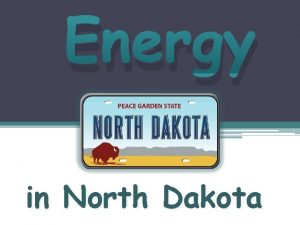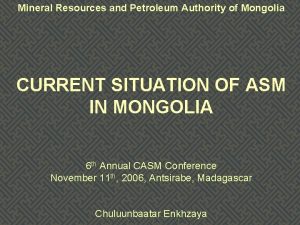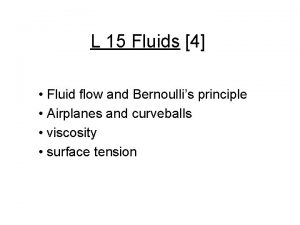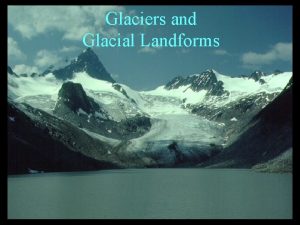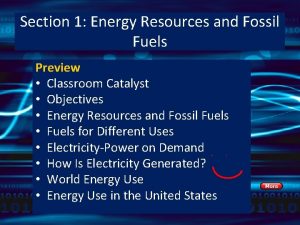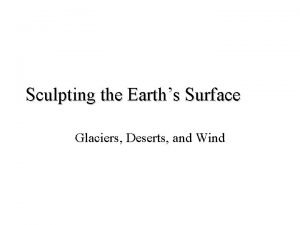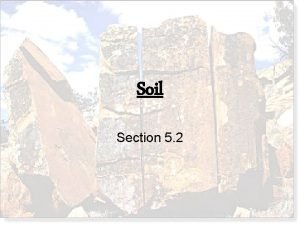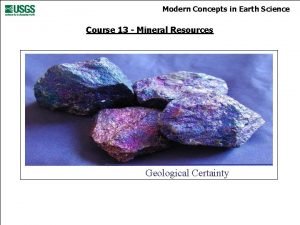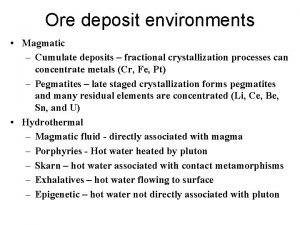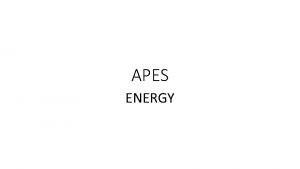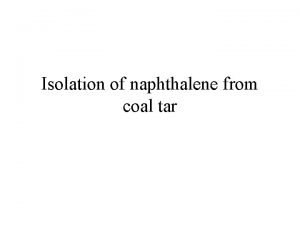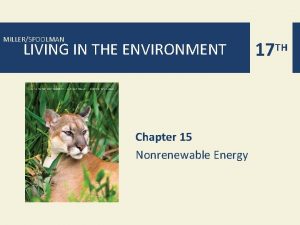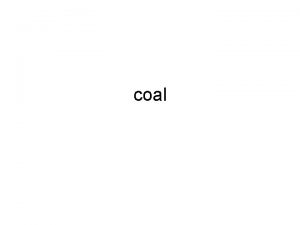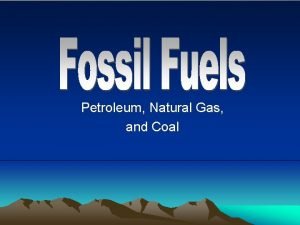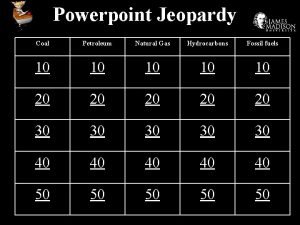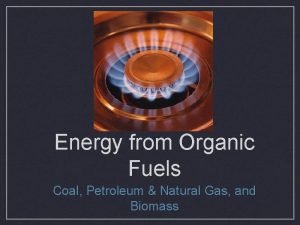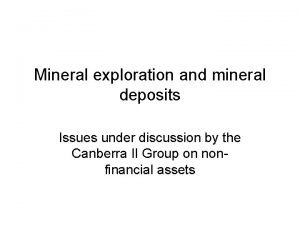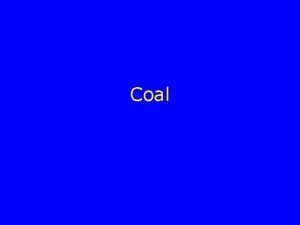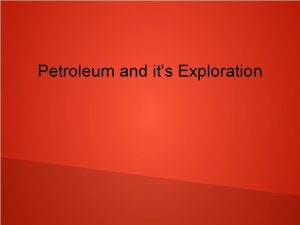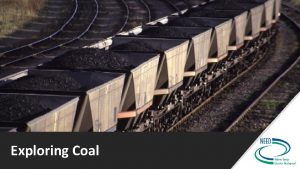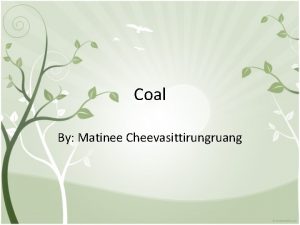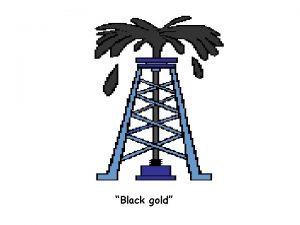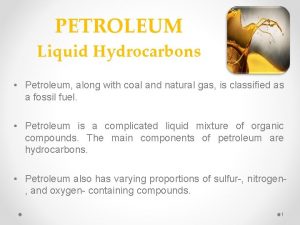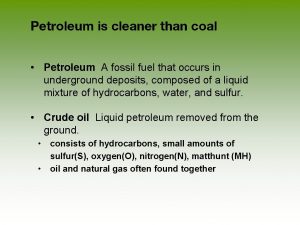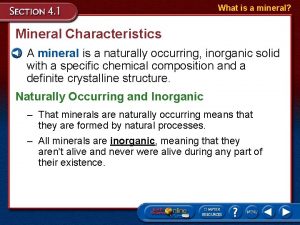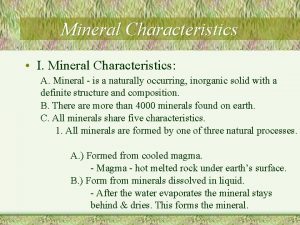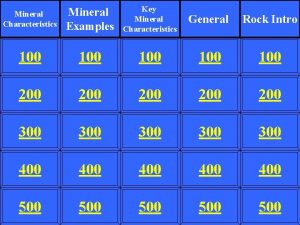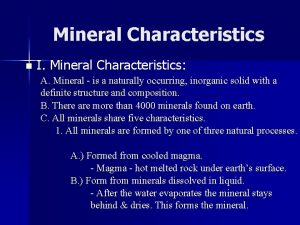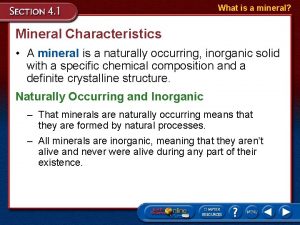11 PETROLEUM NATURAL GAS COAL MINERAL DEPOSITS 1





















![* Rancho Seco [Operational] * Rancho Seco [Operational]](https://slidetodoc.com/presentation_image_h2/4e7468667f124d52fe40267696030ffb/image-22.jpg)










- Slides: 32

11. PETROLEUM, NATURAL GAS, COAL, & MINERAL DEPOSITS 1. ENERGY RESOURCES (Fossil fuels, geothermal, nuclear) 1. 1. Fossil Fuels Energy resources that have formed as the result of the burial and subsequent transformation of organic material. Major Fossil Fuels: Fuels Oil (Petroleum), Coal, Natural gas

PETROLEUM- WHAT IS IT? Ø Petroleum (Rock oil) is a naturally occurring, flammable liquid found in rocks. Ø Complex mixture of hydrocarbons (C 5 H 12 to C 18 H 38) & trace amounts of N and S. Ø may also be found in semi-solid form mixed with sand (oil sand), (e. g. Canada, Venezuela) Crude oil Oil sand Crude oil

OIL SAND It takes two tons of oil sand - a mix of bitumen, sand, clay and water - to make one barrel of oil. Bitumen is upgraded on site or piped further south in Alberta or to the USA, where it is refined into fuels etc. A worker with a handful of black, sticky oil sand

USES OF PETROLEUM ü 84% by volume of the hydrocarbons present in petroleum is converted into energy-rich fuels such as gasoline, diesel, jet, heating, and other fuel oils. ü The 16% not used for energy production is the raw material for many chemical products, including pharmaceuticals, solvents, fertilizers, pesticides, and plastics.

THE PROCESS OF OIL & GAS FORMATION

TEMPERATURE CONDITIONS AT WHICH DIFFERENT HYDROCARBONS FORM OIL T = 100 -160 o. C Natural Gas T = 160 -225 o. C .

THE PROCESS OF ACCUMULATION OF PETROLEUM


(2013) US Energy Information Administration (

Shale Gas Formations in the United

HOW LONG WILL IT LAST? • Known reserves of petroleum: 1. 67 tbl • Consumption: 86 million barrels/day • At 2012 consumption levels, petroleum reserves would be gone by the year 2065. 1, 668, 929, 000 barrels =19, 406 days 86, 000 barrels/day 19, 406 /365 = 53 years 53 + 2012 = 2065 Factors which may extend or reduce this estimate : increasing demand for petroleum in China & India; new discoveries; new extraction techniques (e. g. fracking), and energy

COAL Coal beds Peat Lignite Bituminous Coal Anthracite

THE PROCESS OF FORMING COAL Peat Coal T=100 -200 o. C Peat Coal T=200 -300 o. C Compacted & partly decayed plants transform into peat • Formed from the remains of plants that lived thousands to millions of years ago.

COAL FIELDS OF THE USA Btu: British thermal unit

IN WHICH CLASSES OF ROCKS DO FOSSIL FUELS OCCUR? Sedimentary: Most fossil fuels occur in sedimentary rocks Igneous: Due to the extremely high T involved in the formation of igneous rocks, the fossil fuels get cooked and vaporize. Metamorphic: Fossil fuels vaporize due to the high T during metamorphism; anthracite coal is a metamorphic rock.

1. 2. GEOTHERMAL ENERGY Energy produced by tapping natural underground reservoirs of steam and hot water (300°F to 700°F). https: //www. youtube. com/watch ? v=m. CRDf 7 Qxj. Dk 4 min

Aluto–Langano discharging well, ETH

http: //sciencenordic. com/harnessing-heat-below 9. 5 MIN 1 2 3 http: //www. eia. doe. gov/kids/energy. cfm? page=geothermal_home-basics Imperial Valley Basic info on geothermal energy

Geothermal Power Capacity by State, 2000 (USGS)

1. 3. NUCLEAR ENERGY Cooling Tower Containment bldgs with Nuclear Reactors inside Nuclear Power Plant at Salem, New Jersey. Nuclear power meets about one-third of NJ’s electricity needs.

US NUCLEAR PLANTS
![Rancho Seco Operational * Rancho Seco [Operational]](https://slidetodoc.com/presentation_image_h2/4e7468667f124d52fe40267696030ffb/image-22.jpg)
* Rancho Seco [Operational]

San Onofre Nuclear Generating Station (SONGS) Operated by Southern California Edison (SCE) in San Diego County, has two units (Units 2 and 3). Unit 1 was retired in 1992. As of June 2013, SCE in the process of developing a plan for decommissioning.

WHAT IS NUCLEAR ENERGY? Nuclear energy: q. Energy released by nuclear fission or fusion Nuclear fission q. Splitting of an atomic nucleus into two smaller fragments, accompanied by the release of a large amount of energy Nuclear fusion q. Joining of two lightweight atomic nuclei into a single, heavier nucleus, accompanied by the release of a large amount of energy

Uranium ore Uranium mining in Wyoming was formerly a much larger industry than it is today. Wyoming once had many operating uranium mines, and still has the largest known uranium ore reserves of any state in the U. S. At the end of 2008, the state had estimated reserves dependent on price: 539 million pounds of uranium oxide at $50 per pound, and 1, 227 million pounds at $100 per pound. The Wyoming uranium mining industry was hard-hit in the 1980 s by the drop in the price of uranium. When the uranium price dropped, the uranium-mining boom town of


PRODUCTS OF ENRICHMENT Uranium dioxide pellets, held in a gloved hand, contain about 35% of 235 U, the fission fuel in a nuclear reactor. Each pellet contains the energy equivalent of one ton of coal.

HOW IS ELECTRICITY PRODUCED? Pressurized water reactor 1. Fission of 235 U occurs in the reactor vessel 2. The fission process is accompanied by heat; this heats-up the water to ~293 o. C in the reactor vessel, used to produce steam in the steam generator 3. The steam drives a turbine to generate electricity 4. The steam leaves the turbine & is pumped through a condenser (to convert it back to liquid) before returning to the steam generator 5. Hot water from the condenser is pumped to a cooling tower to control excess heat

2. MINERAL RESOURCES Ore: mineral from which one or more commercial elements can be extracted profitably. Ores Native Gold on Quartz of Copp er Ores of various elements

ECONOMIC CONCENTRATION FACTORS* OF SOME COMMERCIALLY IMPORTANT ELEMENTS In order for a deposit to form, processes must bring about a localized enrichment of one or more minerals.

EXPLORATION TECHNIQUES FOR MINERAL DEPOSITS Integrated Survey involves: Ø Geological mapping Ø Geochemical analysis Ø Geophysical survey

WILL WE RUN OUT OF IMPORTANT METALS?
 As coal deposits were used up, britain turned to
As coal deposits were used up, britain turned to Petroleum and natural gas formation
Petroleum and natural gas formation Mineral resources and petroleum authority of mongolia
Mineral resources and petroleum authority of mongolia Nfpa chapter 5
Nfpa chapter 5 Liquefied petroleum gas properties
Liquefied petroleum gas properties Sedex ore deposits
Sedex ore deposits Sarita deposits $1000 in an account
Sarita deposits $1000 in an account Metamorphic rocks in michigan
Metamorphic rocks in michigan Function of commercial bank is
Function of commercial bank is The fraction of checkable deposits
The fraction of checkable deposits Calcium deposits
Calcium deposits A petty cash fund is always replenished
A petty cash fund is always replenished Tidal deposits
Tidal deposits Chapter 11 section 2 stream and river deposits answer key
Chapter 11 section 2 stream and river deposits answer key Calcium deposits
Calcium deposits Personal bank account 7 habits examples
Personal bank account 7 habits examples Piedmont
Piedmont Lesson 4.6 online banking answers
Lesson 4.6 online banking answers Mvt deposits
Mvt deposits Section 1 energy resources and fossil fuels answer key
Section 1 energy resources and fossil fuels answer key Glacial deposits
Glacial deposits Pedalfer soils would most likely be found
Pedalfer soils would most likely be found Ritika deposits 200 every month
Ritika deposits 200 every month Emotional bank account examples
Emotional bank account examples The multiple expansion of checkable deposits
The multiple expansion of checkable deposits Vms deposits
Vms deposits Ore deposits
Ore deposits Calcium deposits
Calcium deposits Repleneshed
Repleneshed Haworth synthesis of naphthalene
Haworth synthesis of naphthalene What is coal
What is coal Coal beds
Coal beds Coal candy with hammer
Coal candy with hammer

